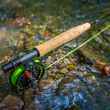As it does every year, the industry toted its biggest and best new products at this year's IFTD/ICAST show in Orlando, Florida. The breadth of new products this year came as a surprise to many, given how prolific and innovative manufacturers across the industry have been over the last few years.
Even with three days spent walking the floor of this year's show, there was scarcely enough time to take in all the new offerings. What follows are just some of this year's standouts in new rods, reels and lines.
Rods

Sage X
The belle of the ball, Sage’s new X stole a great deal of the spotlight at this year’s show by being the first rod to ever walk away with wins in three categories: Best Freshwater Rod, Best Saltwater Rod and Best in Show. The X is built on Sage’s latest material innovation, KonneticHD, born in the labs at the company’s Bainbridge Island headquarters.

G. Loomis Asquith
As we noted in an earlier article, G. Loomis is back with its first flagship fly rod release in over six years, and to much fanfare. While its NRX has remained one of the most heralded rods in the industry, Loomis’ new entry, the Asquith, looks to set the bar even higher. The Asquith is also a rod birthed by unique materials and a proprietary blank construction process called Spiral X, a product of Loomis parent company Shimano.

Winston Air
Winston surprised everyone with a major new rod release in it’s new Winston Air which, as you probably guessed, Winston is toting for its light weight. But, Winston isn’t just calling it the lightest fly rod they’ve ever made, they’re calling it the “finest performing” fly rod they’ve ever made. Like the Sage X and G. Loomis Asquith, the Air was one of the most talked about rods at the show. With an action that fits in somewhere between Winston’s Boron IIIx and their Boron IIIx plus, the Air is also a product of material advancements. In Winston’s case, it is advancements in their resin system. Using their new SuperSilica resin, Winston says it was able to cut weight and increase performance in the Air.

ECHO Bad Ass Glass
The glass revolution continues. While fiberglass is typically the dominion of slow-action, dry fly tossing trout rods, ECHO has ventured into the world of faster glass rods geared for more demanding fishing environments (think saltwater flats), a place few other manufacturers have gone. The color alone, even though you know it shouldn't, will make you ache to own this rod. Available in #8, #9, #10 and #12 for a friendly fiberglass price.

Orvis Helios 2 Covert
This is the kind of project that we can’t help but love Orvis for repeatedly taking on. Feedback about rod flash from Helios 2 lovers in spooky-fish environments prompted Orvis to build the Helios 2 ‘Covert’. It’s likely not a rod that Orvis expects to go flying off the shelves, but one it has built to serve the needs of anglers. It’s the same Helios 2 we’ve known for years, but in a stealthy, subtle matte black finish that has Orvis sporting a little bad assery of its own.

Scott Flex
The Flex is Scott’s replacement for its entry-level A4. According to Scott head rod designer Jim Bartschi, the Flex is more ‘Scott’ than any entry-level rod the company has built before. Scott says it has built innovations developed in its award-winning Radian and Meridian rods into a more affordable package in the Flex, resulting in a rod that has more pop in the mid and butt sections, better lateral stability. Upgraded componentry comes along for the ride.
Reels

Sage 6200
Sage never seems to get the credit it’s due for building tough, dependable, high-performance reels that always seem to cost just a bit less than you expect them to. All of Sage’s reels are designed at their Bainbridge Island, Washington facility but, yes, they’re made overseas, so if that’s a sticking point for you — move on. But if your primary concern is quality and performance, take a hard look.

Redington Rise
Redington has been selling loads of its 2015-introduced diecast reel, the Behemoth, which sports a monster drag package and a cutting edge spool design in stupidly affordable package. This year, Redington brings its refresh of its RISE reel to the table. The RISE, which is fully machined 6061-T6 aluminum packs in features like a large-arbor, line and backing-packing spool, oversized drag knob and strong carbon disc drag that you typically find in reels that are at least twice as expensive. Yes, the drag on the RISE isn’t sealed, but you could always rinse your reel after fishing, as you should be anyway.

Bauer SST
R.L. Winston bought Bauer this year, which was news welcomed by folks that have long lauded Bauer as one of the more innovative reel companies in the industry, but one that needed a bit of energy infusion. The Winston purchase seems to have brought along just that and a reinvigorated Bauer joined Winston’s display of a bevy of new products. Bauer’s SST, with it’s one-of-a-kind front-accessed star drag knob — previously part of Bauer’s CFX lineup — joins a new larger arbor spool in the SST. Bauer likes to call it’s carbon-disc drag system the smoothest out there, and whether that’s the case is likely up to debate. What’s not, is its silky smoothness and almost indetectable startup inertia.
Lines
Scientific Anglers Amplitude
SA’s new AST Plus additive, the hallmark of its new Amplitude lines, may be the biggest innovation in fly lines this year. The company is making big claims about it’s new slickness additive which, if they hold up, could usher in a new era of fly line durability and longevity. Here’s the rub: AST plus, found in all Amplitude lines, results in a line that is reportedly 40% slicker than a ‘normal’ line. What may be more important, however, is that SA notes it doesn’t wear off. AST plus is impregnated throughout the line’s coating and actually migrates out to the surface over time, resulting in a line that gets more slick as it ages, not less.
Airflo Skagit Scout
Airflo has taken everything it learned about making small, compact Skagit heads like the Skagit Compact and Skagit Compact G2 and gone even further. The result is Airflo's new Skagit Scout, a 15.5' Skagit head geared at one-handed rods (Airflo is offering them all the way down to 150 grains) and smaller two-handers and anglers fishing in tight conditions with little backcasting room. According to Tim Rajeff, even casters unexperienced with spey casting can load up the Skagit Skout and a sink tip, and fire a 50-60' cast using their standard 9' 5-weight rod. If that doesn't sound good, what does?
RIO Big Nasty
Speciality lines may seem like overkill sometimes, and there are no doubt times when they are. Throwing big bugs isn’t one of them. For some time now RIO’s Outbound short have been go-to lines for anglers that toss big flies at musky, fish mouse patterns to voracious rainbow trout and so on. RIO’s Big Nasty, with its longer head and even more aggressive front-weighted taper, took home ‘Best Freshwater Fly Line’ honors and offers another option for mega-fly tossers.
Winston Energy lines
The biggest secret in fly rods may be how important your line choice is. Take the best rod on the market and throw a crappy or poorly matched line on it, and you’ve got a dud in your hands. Winston, for its part, wants that problem to be one of the past. As a result, they’ve introduced a lineup of ‘Winston Energy’ fly lines designed specifically for use on Winston rods. The lines were designed using what Winston calls a one-of-a-kind bit of engineering using something called a digital deflection board, that allowed them to map energy transfer between fly line and fly rod at varying points along the rod blank. The result, Winston notes, is a fly line designed specifically for Winston tapers and one that eliminates the ‘What’s the right line for my fly rod?’ worry facing anglers.






























Comments